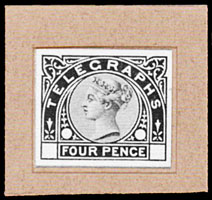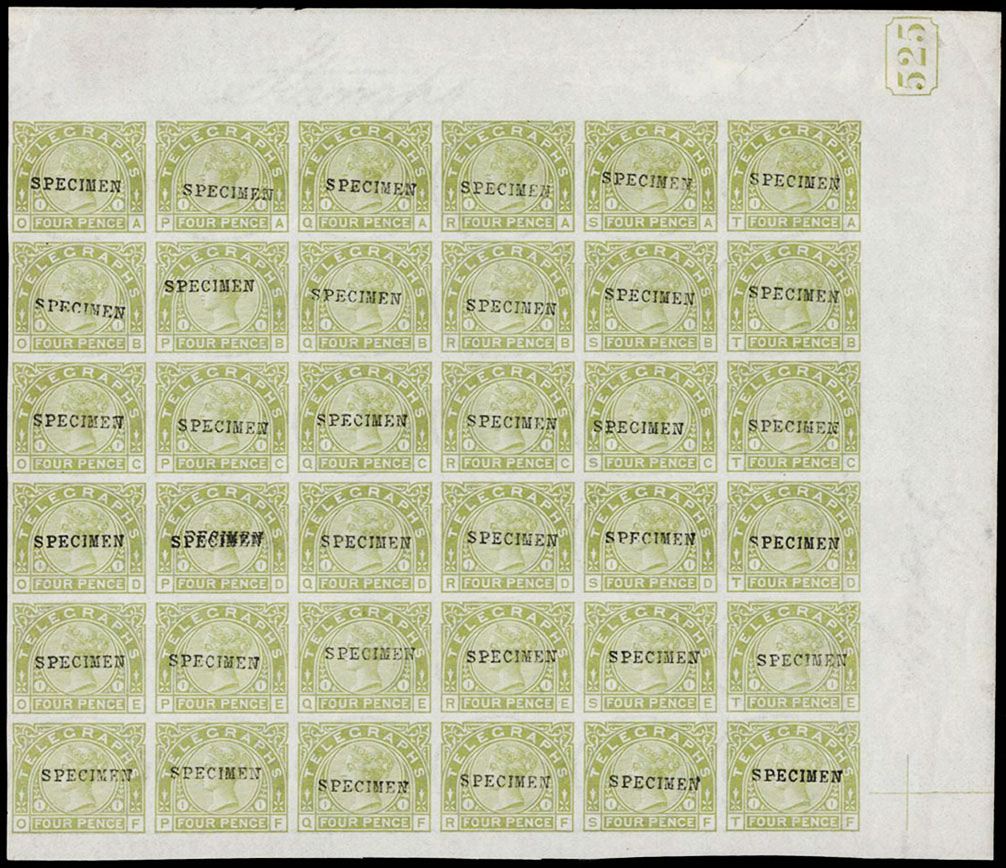1 Essays
2 Die Proofs
3 Sheet Layout
4 Plate Proofs
5 Paper
6 Colour Trials
7 Imprimaturs
8 Colour Standards
9 Specimens
10 Issued Stamps

Date: 1 Mar 1877
Plates: 1-2
Printer: De La Rue
Watermark: Large Garter (sideways)
Perforation: 14
Soon after the first issue of telegraph stamps on 1 Feb 1876 there was a demand for more values. On 24 Mar 1876 the Postmaster General approved six new values: 4d, 6d, 3s, 10s, £1, and £5.
It had been decided that telegraph stamps of the same value as postage stamps would be printed in the same colour and on the same paper as the corresponding postage stamps, hence this stamp was printed in sage-green on Large Garter paper.
Two plates were prepared and registered, imprimaturs exist from both, but only the registration sheets were printed from plate 2.
Essays
Several essays were prepared by De La Rue for the second issue, including designs lettered ‘C’ to ‘H’ and dated 21 Apr 76. Approved designs of all six values were submitted later but are undated. All of these are now in the Royal Philatelic Collection.
The lettered essays for the 4d are confusing as the design was swapped with the 3s. Also essays ‘C’ and ‘D’ were endorsed to be superseded by ‘A’ and ‘B’ but it is unclear if the latter ever existed.
| C | 3s | 77 | NN | violet, selected for the 4d |
| D | 4d | 66 | NN | red, selected for the 3s |
| — | 4d | 77 | NN | red, approved design |
For more details on second issue essays click here.


These are from a set of 12 black & white essays which are undated but believed to be circa 1880. Their purpose is not known, but they are likely not related to the issued stamps.
| — | 4d | — | — | black & white |
| — | 4d | — | — | black & white |
For more details on black and white essays click here.
Die Proofs
Die proofs are printed in black on white glazed card, typically 92 x 60mm, unless otherwise noted. They are listed below ordered by date, with undated proofs following those with the same plate number. The rightmost column gives the number recorded in our database: in private hands + institutionalised.

To see more 4d Die Proofs click here.
| 1 | Oct 30, 1876 | — | — | — | 5 + 2 |
| 2 | Oct 31, 1876 | — | — | — | 6 + 1 |
| 3 | Nov 1, 1876 | — | — | — | 5 + 1 |
| 4 | Nov 2, 1876 | — | — | — | 7 + 1 |
| 5 | Nov 3, 1876 | — | — | — | 8 + 1 |
| 6 | Nov 4, 1876 | — | — | — | 7 |
| 7 | Nov 6, 1876 | — | — | — | 4 |
| 8 | Nov 7, 1876 | — | — | “BEFORE HARDENING” | 7 + 1 |
| 9 | no date | — | — | Basic Die Proof | 2 + 1 |
| 10 | Nov 17, 1876 | 1 | — | “Before HARDENING”, “FJ” | 1 |
| 11 | Nov 17, 1876 | 1 | — | “Before Striking”, “FJ” | 1 |
| 12 | Nov 21, 1876* | 1 | — | “AFTER STRIKING”, “FJ” | 2 |
| 13 | May 14, 1877 | 2 | EB | “BEFORE STRIKING”, “HA” | 1 |
| 14 | May 25, 1877 | 2 | — | “AFTER STRIKING”, “HA” | 1 |
* Smudged “6” looks like “1878”.
SG lists partially dated “Nov 76” between Nov 3 and Nov 4. Not seen by us.
Institutionalised/Total: 8/63.
From the Striking Books


| Nov 21, 1876 | 1* | — | “Nov 21 / 240 Leads”, “Dec 30.76 / P” | 0 + 1† |
| May 24, 1877 | 2 | — | “May 24 / 240 Leads”, “June 20.77” | 0 + 1† |
* Plate number “1” in manuscript.
† Langmead Collection — reconstruction.
In a Countersunk Frame


| no date | — | — | Cut down, set in a countersunk frame | 2 |
Sheet Layout
The sheet had 240 stamps in four panes, arranged two by two. Each pane had 60 stamps in six rows of ten. To the left of each pane reading upwards was “TELEGRAPHS FOUR PENCE.”. Plate numbers were in the upper left and lower right corners, current numbers in the lower left and upper right corners, all reading upwards. At the middle of each side was a cross used as a perforating guide.
A Post Office sheet was one pane, valued at one pound.

Computer generated image, click to enlarge.
Plate Proofs

Plate proofs are only known for plate 2.
The reconstruction shows there was a block of six, or possibly twelve if AJ-BL were included.
Red represents an institutionalised example.
Green a known example in private hands.

One pair is intact in the Royal Philatelic Collection: CL-DL.
DK is in the Langmead Collection and is illustrated in Wright and Creeke.
Paper
The 4d telegraph stamp was printed on the same paper as the corresponding postage stamp. It was printed on Large Garter paper.

The watermark as seen from the front of the stamp.
For more details on Large Garter paper click here.
Colour Trials
For the second issue, colour trials were taken for all six values. They were dated “15 DEC 76”. The 4d was to be in the same colour as the corresponding postage stamp so only one sheet was submitted. The trials are usually described as deeper than the issued colour, but both trials and issued stamps vary in colour depending on how they have been kept, and we see no difference.
Three types of Specimen overprint are all from the same sheet:

Type 8 diag down

Type 8 horizontal

Type 11 diag up
Most examples are Type 11. There are just three examples of Type 8 diagonal down known to us, JI, JJ, and JK. JI is part of a block of nine HG-JI (the other eight of which are Type 11). Both JI and JJ are in the Langmead Collection. There may be more in the unknown positions. There are just two examples of Type 8 horizontal known to us: TK and TL.
| Type 8: | Diag Down | Horizontal | Diag Up |
| Type 11: | Diag Down | Horizontal | Diag Up |

Red represents an institutionalised example.
Green a known example in private hands.

The 4d is the scarcest of the colour trials, mainly as one pane of 60 is completely unknown to us, most of a second pane is in the Langmead Collection, and the other two panes suggest large central blocks are also unknown or lost.
The right margin has manuscript “Same colour as 4d Postage” and datestamp “15 DEC 76”.

Reconstruction.
Click the images to enlarge.
To see a full sheet reconstruction click here.
Imprimaturs



Plates 1 and 2 were registered on 12 Jan 1877 and 18 June 1877. Plate 2 vertical strip of three BG-BI has been incorrectly described as “imperforate — not from the imprimatur sheet”.
The registration sheets for the Telegraphs have been lost. However, we can reconstruct them from known examples and a clear pattern emerges. Most have a column of 12 taken, plus four from the adjacent column, and a plate number example from the opposite corner. One sheet of each value has an extra column of 12 taken.
Plate 1 BB is listed in Langmead and Huggins, but this is an error copied from an auction catalogue. Plate 2 DK is also listed, but this is a plate proof in the Langmead Collection.
Red represents an institutionalised example.
Green a known example in private hands.
Blue is unknown but predicted by the pattern.

| Institutionalised/Total: | 8/17 |
| Royal Philatelic Collection: | AA, TL |
| British Postal Museum: | BI, BK |
| German Postal Museum: | — |
| Tapling Collection: | AD |
| Langmead Collection: | AL |
| Phillips Collection: | AB, AG |

| Institutionalised/Total: | 9/29 |
| Royal Philatelic Collection: | AA, TL |
| British Postal Museum: | CI, CK |
| German Postal Museum: | BD |
| Tapling Collection: | AG |
| Langmead Collection: | AL |
| Phillips Collection: | AE, AF |
Colour Standards

One complete sheet came on to the market in the 1930s: plate 1, imperforate, overprinted Specimen Type 9 horizontally. The stamps are mostly in blocks and scarce as singles, although recently a block of 30 PG-TL has been split.
Red represents an institutionalised example.
Green a known example in private hands.

Block GD-JF is in the Langmead Collection.
Click the images to enlarge.
Specimens




Plate 1 Type 9: scarce, from 3 panes (AA-JF, KA-TF x2), 3 pairs, blocks of 4 (x2) and 6 known.
Plate 1 Type 9b: common, from 6 panes (KG-TL x6), blocks of 4 (x8), 28 (x3), 30, 60 known.
Plate 1 Type 9c: scarce, from 2 panes (AG-JL x2), pair, strip of 4, blocks of 4 (x3) and 20 known.
Plate 1 Type 11: common, from 5 panes (KA-TF x5), 5 pairs, strips of 3 and 5, blocks of 4 (x9), 6, 8 (now split), and 9 known.
Type 9 sub-types can be determined from the corner letters as they come from different panes.
Click the images to enlarge.
Reference to scarcity, blocks and the number of sheets or panes so treated is derived from reconstructions of known examples within our database.
Issued Stamps
Stamps were issued from plate 1 only.
The usage frequency graph shows that plate 1 was used across the whole period of the second issue.
Click the graph to enlarge.
Postal, fiscal, and railway usage are rare, with a registered cover (one of many philatelic covers sent locally to this Liverpool address), one postal usage (possibly fake), and only 308, 474, 694, 855, and 1439 “English Station” railway numerals known to us.
Issued Stamps — Plate 1
Plate 1 (current no. 525) was registered on 12 Jan 1877 and put to press on 15 Jan 1877. It was taken from press in Oct 1881 after printing about 25,000 sheets.
Scarcity #13 in mint telegraphs, #13 in used telegraphs.


No mint multiples are known to us.

Three used pairs are known to us, one horizontal, one vertical, and one vertical perfin. The earliest known used example is 8 Mar 1877 at New Bond St / Grosvenor St W (illustrated).

Inverted watermarks are rare, but they are difficult to identify so there could be a few more. Four used examples are in our database.
Issued Stamps — Plate 2
Plate 2 (current no. 533) was registered on 18 June 1877 but not put to press. Only the registration sheets were printed. Imprimaturs exist, but no perforated examples are known.














